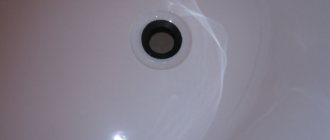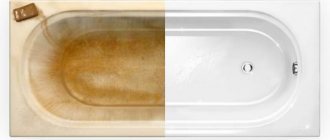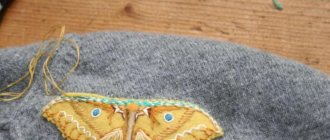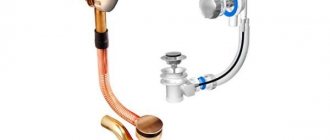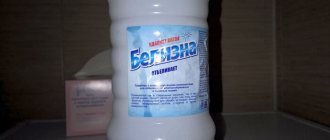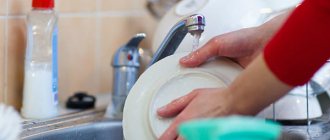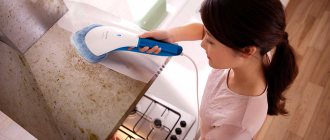If cleaning is not done regularly, the bathroom quickly becomes the dirtiest place in the house. Lime and soap deposits, traces of mold, dust and cobwebs not only spoil the appearance of the room, but also pose a danger to residents.
To maintain order in the bathroom, you need to distribute tasks according to regularity, optimize the space and select effective cleaning products.
Destroying bacteria
In addition to rust, dirt and microbes accumulate on the surface of the bathtub, which should be gotten rid of. The following recipe will help.
- Mix half a glass of vinegar, a glass of alcohol and a quarter glass of soda;
- apply to the surface and wait 20 minutes;
- wipe the bath with a sponge and rinse with warm water - the dirt will be removed without effort.
Preparation of equipment and funds
You should follow a certain algorithm when cleaning the bathroom. Then it will always have a beautiful and well-groomed appearance, and most importantly, be safe for use.
Step-by-step cleaning algorithm:
- Cleaning your sink, toilet and drains daily will save time in the future. Since you won’t need to remove stubborn stains and spend hours on it. And it’s quite possible to devote 5-10 minutes a day to cleaning. This will be enough to maintain cleanliness;
- It is necessary to disinfect the toilet rim daily using special cleaning products. This will prevent the spread of bacteria and the appearance of new ones.
- Cleaning the drains and treating them with special products will also prevent the spread of bacteria. And in the future there will be more blockages. It won't take much time. However, it will avoid negative consequences.
- After taking a bath, you should always rinse this sanitary fixture with clean water. This will prevent the formation of soap streaks and stains. And it is imperative to remove hair from the drain. If you have pets, you need to remove their hair after bathing them.
- You need to be careful when choosing detergents. They should be different for the toilet and bath. So many toilet products can damage the surface of the bathtub.
- The main thing you should not forget about when cleaning the bathroom is cleaning the pipes. To do this, special means are used to get rid of blockages. Cleaning must be done at least once a month. If not handled properly, the pipe may become clogged. More serious and expensive measures will have to be taken to clean it up.
- If the bathroom has glass surfaces, you need to wipe them with special detergents once a week. Because over time, soap stains form on them. And the longer cleaning is not carried out, the more difficult it is to clean the glass.
It is necessary to treat the bathtub and especially the floor in the shower stall with disinfectants weekly. Since bacteria and fungus develop very quickly on such surfaces.
Before you start cleaning the bathroom and toilet, you need to carefully inspect the room. Look into the most inaccessible places where you haven’t looked for a long time. It is necessary to outline an action plan:
- To clean the bathtub and toilet, use soft sponges and cloths. Since hard sponges can damage the enamel and ruin the appearance of the surface.
- Bath accessories need to be changed every 2 months. This will prevent the growth of bacteria.
- It is necessary to monitor the condition of the seams between building materials and equipment and devices. They require special care.
- You need to pay attention to mixers and taps. In addition to soap deposits, they tend to become unusable, leak, and not close tightly. This leads to water leakage.
Only after the inspection has been completed and the inventory has been prepared is it time to deal with the cleaning supplies.
To clean the bathroom, you need to use several detergents that will help you cope with various stains. The main tools that are most often used are:
- disinfectants to fight bacteria;
- from limescale;
- for glass, mirrors and tile cleaning.
The ingredients listed above will help with cleaning. After all, very often in the bathroom you can encounter soap stains, mold and other stains. In the fight against them it is necessary to use “heavy artillery”.
Cleaning the toilet
Once again, baking soda will help us. You will need a pack of sodium bicarbonate and some water.
- Mix a glass of baking soda and water to make a paste.
- We apply it to the bowl using an old toothbrush, and pour the remaining powder into the knee.
- A toilet that has stood like that all night should be cleaned with a brush and flushed.
What difficulties may arise when cleaning the bathroom?
Along with the kitchen, the bathroom is one of the most difficult areas to clean in an apartment.
This is due to the following factors:
- Large number of surfaces. In the limited space of the bathroom there are plumbing fixtures, large household appliances, shelves and cabinets. Despite the small size of the room, the total surface area in it can be larger than in the living space. All of them require regular washing and dusting.
- High humidity. Air saturated with water vapor promotes the rapid proliferation of bacteria and fungi. Poor ventilation aggravates the situation, so you need to regularly check the permeability and cleanliness of the ventilation duct.
- Active use of cosmetics and household chemicals. Traces of soap, toothpaste, cream and shaving foam form an unpleasant cloudy coating on surfaces, to which dust and dirt stick well. If the bathtub coating is damaged, colored streaks from scrubs, hair pigments and other cosmetics may remain on it.
- Presence of hard-to-reach places. Pipelines, ventilation, surfaces behind the washing machine and water heater, and the space under the bathroom are difficult to clean. At the same time, moisture, dust and even cobwebs often accumulate there.
An additional complication is the toxicity of some detergents. In a small space, household chemical vapors can reach sufficient concentrations to make you feel worse.
During general cleaning, the risk of side effects increases, because... Different detergent compositions can form toxic compounds.
List of cleaning products that are prohibited from combining
| Facilities | Toxic substance | Side effects |
| Chlorine bleach and ammonia (ammonia) | Chloramine (vapour) | Shortness of breath, chest pain, dizziness, breathing problems, lacrimation. |
| Chlorine bleach and ethanol (alcohol) | Chloroform (vapour) | Headache, dizziness. |
| Vinegar and chlorine bleach | Chlorine (gas) | Cough, sore throat, watery eyes, breathing problems. |
| Vinegar and hydrogen peroxide (when mixed in 1 container or on 1 surface) | Peracetic acid | Irritation to eyes, skin and mucous membranes. The substance is flammable. |
Ammonia and alcohol are often found in glass cleaning sprays, while vinegar and peroxide are often found in home cleaning products. If you plan to wash surfaces with incompatible components, then you need to thoroughly ventilate the bathroom between them.
Toothbrush/brush cup
- change every 3 months/clean once a week
If you are not yet impressed by the information received, then read about toothbrushes. We have already talked about the possibility that splashes of water from the toilet may fall on towels hanging nearby. A similar situation can occur with a toothbrush, so in a shared bathroom, keep the hygiene item away from the “latrine”, preferably in a cabinet. But do not forget to provide them with enough air, because you remember that a wet environment is the best friend of microbes.
see also
A few tips on how to unclog a drain with your own hands
Bath mat
- clean once a week and change every 3 months
Usually you get out of the shower and step on the mat. That is why it is considered a high-traffic area, especially when several people use the bathroom. Just like bathroom curtains, rugs need to be replaced every 3 months and washed every week.
Since most specialty flooring materials are typically quite thick and rubberized, it is important to ensure that they are completely dry after use. According to microbiologist Philippe Tierno, “complete drying kills microorganisms and prevents their reproduction and growth.”
Curtain or partition?
Glass partitions instead of curtains in the bathroom look impressive, but you need to constantly remove drops from them with a scraper, otherwise they will look terrible. The same difficulties with showers. You can make your task easier by treating surfaces (including sanitaryware) with a special water-repellent coating or buying already treated material.
Built-in plumbing
Parts of plumbing fixtures hidden in the wall do not need to be dusted or washed - the benefits are noticeable. And if the plumbing is suspended, then cleaning will become even more convenient. You can simply walk under the wall-hung toilet with a mop, rather than washing all the nooks and crannies. If you do not want to build in plumbing, opt for the simplest form possible - without threads, unnecessary bends and other decorative elements.
Switches and door handles
- clean once a day
More often than not, we don't wash these items at all. But just think about how many times and how many people touch light switches and door handles every day. The situation is especially aggravated when a large family lives in the house. To prevent the growth of bacteria and get rid of their secretions, wipe the areas daily, ideally using disinfectants.
Original article: How Often Should I Clean These 15 Things In My Bathroom?
Photo: Buzzfeed
How to prepare for cleaning?
Effective cleaning requires some preparatory measures. In this case, you should free up as much space as possible. Otherwise, given its small volume, cleaning will be difficult.
Take a large container (a box, for example), and put in it everything that can be removed from shelves, pulled out of cabinets, or moved. If there is a rug on the floor, remove it. If the rug can be washed, do so.
Many people prefer to cover the bathtub with a curtain to prevent water from flying around. The solution is reasonable, but during cleaning, the curtain must be removed. It is possible that she herself needs cleaning.
Towels, bathrobes and other accessories should also be taken away for a while. Having freed up your workspace, you can start cleaning directly.
Cleaning and polishing faucets, shower heads and hoses
First of all, you need to think about the accumulation of scale and other foreign matter from the water inside the faucets and showers. In the absence of a filter at the inlet of the wiring or for each individual plumbing fixture, various debris penetrates and accumulates, the situation is aggravated by infrequent cleaning, and in the future even cleaning may not save.
The principle of self-destruction is very simple. Scale, lime, and debris accumulate inside the faucet aerator or in the shower head after poor water purification, causing the outlet holes to become clogged. Further, the metals begin to corrode, whole white-yellow growths form inside and outside, which, if you miss the moment, cannot be removed without using a mechanical cleaning method. But rubbing with sandpaper or piercing plumbing fixtures with air pressure does not always work “without casualties.” Many inexpensive faucets already serve no more than a few years, but with such a radical approach, they immediately break, burst, or crack. Rust, lime, and oxidation corrode weak alloys, and the mixer is thrown away. Therefore, it is worth paying attention to cleaning these accessories more often!
- Mixer. You need to remove the aerator - a small screw-on tip on the spout for spraying water, clean it by hitting it on a hard surface so that all the hard debris spills out. And then rinse under strong water pressure on all sides.
- Shower head. It is necessary to unscrew the spray pad and clean it on both sides. The outer decorative part is cleaned carefully; you can even use a stiff brush on the back side, and punch holes with a steel sewing needle or sharpened wire.
The surfaces of faucets, their taps and levers, shower heads and hoses are cleaned with vinegar solution, alcohol, and plumbing polishes without abrasive particles. Heavy stains can be scrubbed with a hard washcloth, after dipping it in wine vinegar, baking soda solution or a concentrated descaling agent!
Bright hues
Light colors show dirt better, while dark colors show dust and traces of drops, so it’s better to give preference to light colors. You should not choose snow-white grout for tile joints; gray will be more practical. For white tiles, you can even go with a glossy finish, but for black tiles this would be a killer combination.
How to clean a wooden bathroom
Wooden surfaces intended for the bathroom are treated with waterproof compounds. To avoid damaging the coating, you can use potato juice, a solution of dishwashing detergent (30 ml per 1 liter of water), lemon juice or white vinegar (2-3 tbsp per 50 ml of water) for cleaning.
Among the industrial products for cleaning wood, Amway LOC, Oak-Y Dokey Wood Cleaner, and Natural Shine Furniture Cleaner are suitable. Presto Clean wipes are used to remove stains.
General cleaning procedure
To increase the efficiency of cleaning, it is necessary to immediately determine the range of tasks and the sequence of their implementation:
- inspect all places for storing things and household supplies;
- clean surfaces from top to bottom;
- wipe mirrors, floors and glass doors.
Washing towels and other woven items
It is recommended to wash cotton towels at the maximum temperature that the machine allows. This allows you not only to destroy all bacteria and fungi from the fabric, but also to additionally clean the drum of the device.
Synthetic products (for example, bathrobes) are washed at +30...+40°C without adding bleaches or conditioners.
Microfiber cleaning equipment is loaded separately from other things, as it easily collects threads, hair and lint. It is advisable to wash rags in a delicate cycle and without machine spinning.
Inspection of the contents of the lockers
An obligatory stage of general cleaning is cleaning the cabinets and niches in which household and cosmetic products are stored.
What to pay attention to when disassembling stock:
- expiration dates;
- compatibility with nearby liquids (it is not only undesirable to use glass sprays, but also to store them next to chlorine bleaches);
- integrity of packaging and lid;
- composition (for example, you should not store in a cabinet a product that you have stopped using due to allergies or switching to biodegradable compositions).
When auditing your cabinet, you can make a list of household and cosmetic products that are running low.
To more accurately assess the condition of cosmetics, it is advisable to write the date of opening on the packaging before use. When sealed, creams and serums can be stored for 1-2 years, and when opened, no more than 2-6 months.
Wiping cabinet shelves and cabinets
After emptying the cabinets, you need to wipe the shelves from dirt, dust and drips of household products. Glass and plastic items can be removed from their holders and washed thoroughly with soap and water. Shelves made of MDF and chipboard are carefully wiped with a damp cloth.
Ceiling cleaning
To clean the ceiling, use a stepladder, a vacuum cleaner, a mop with a long handle and a soft cloth that does not leave lint. After removing dust and cobwebs, you can begin washing the surface.
Which ceilings can be washed:
- tension;
- rack (made of plastic panels);
- painted with waterproof acrylic or latex paint.
In all three cases, it is recommended to use a soap solution. If the stain is severe, you can add a little dishwashing detergent to the water and rub the stain with a soft sponge.
Glossy stretch ceilings can be washed with glass cleaner.
To clean the ceiling, do not use solvents, alcohol, acetone, strong alkalis or acids. If you plan to use a new product, you need to test its effect on a small section of the ceiling in the corner above the bathroom.
Removing dirt from ventilation
To check the ventilation condition, you need to press a piece of paper against the grille or air duct opening. If it does not press against it due to the outflow of air, then the channel needs to be cleaned.
How to clean the ventilation:
- remove the grill covering the hole, free it from small debris and dust;
- soak it in a soap-soda solution;
- Using a vacuum cleaner, clean the lower part of the channel from dust and cobwebs;
- Wearing gloves and standing on a stepladder, carefully remove the debris within the reach of your hand;
- re-check the drawing capacity with a sheet of paper;
- wash the grill and put it back.
If the ventilation remains inoperative, you need to call a specialist.
Walls and tile joints
Tile walls can be washed with soapy water or special tile products. You need to wash stains with a soft sponge or cloth. Abrasive agents (soda, powder, salt) are allowed only when cleaning tile joints.
To treat walls against mold, you can use a vinegar solution (200-250 ml per 1 liter of warm water) or a steam generator.
Cleaning the bathroom
The bathtub and shower can be cleaned with a mixture of vinegar and dish soap (1:1), a solution of ammonia (1:10) or citric acid (1 tbsp per 200 ml of water), as well as soda and vinegar. In the latter case, you need to wash the enamel with a soda solution (3 tsp soda per 200 ml of water), and then treat it with vinegar.
Acrylic bathtubs and trays can only be washed with soapy water or special products.
Sinks and faucets
The sink should be cleaned with cream products with an acidic pH. Powders and pastes with abrasive particles make the process faster, but damage the earthenware surface, which is why dirt accumulates faster after cleaning.
To remove traces of hard water, wipe the faucets with a vinegar solution or a slice of lemon.
Cleaning the toilet and sewer pipe
You can clean the toilet with products based on oxalic acid and bleach. To remove plaque, you can pour 1 liter of Coca-Cola into the bowl and leave for 30-60 minutes. The internal surfaces and tank are treated with a commercial disinfectant for cleaning toilets or a mixture of peroxide and ammonia (9:1).
To prevent the formation of thick plaque and the proliferation of bacteria, you can use toilet tablets.
Mirror polishing
You can wipe mirrors not only with special sprays, but also with home remedies:
- milk;
- a solution of vinegar in water (1:1);
- ammonia with soft tooth powder (1:1 or 2:1);
- alcohol (for hairspray stains).
The cloth for wiping glass must be clean, dry and lint-free. To avoid leaving streaks, you need to clean the surface in a circular motion. Fresh splashes can be removed with acidified water and a paper towel.
Disinfection of children's toys
Silicone and hard plastic toys are dishwasher safe. It is better to wash soft plastic and rubber products (for example, bath ducks) with soap and water immediately after finishing the water procedures.
Once a week, you can soak them in a bowl of weak vinegar solution to prevent mold. After 2-3 hours of soaking, the toys should be washed with a sponge, rag or brush and rinsed with running water. After drying, they should be sprayed with alcohol and allowed to stand for 1-2 minutes.
It is advisable to store toys outside the bathroom. If there is good ventilation or there is a heated towel rail, you can put them in a closed cabinet away from the bathtub and sink.
Floor cleaning
For daily cleaning, you can wipe the floor with a damp mop with automatic spin. Once a week, you need to wash the tiles by hand or add floor cleaner to the water.
You can clean the tile joints from dirt using the hard side of a sponge and soap, an old toothbrush with soda or abrasives.
Final touches
At the final stage of cleaning, you can perform the following actions:
- disinfect switches and door handles;
- wipe all glass and metal surfaces dry;
- wipe bottles with cosmetics and cleaning products, put them back in the cabinets;
- replenish supplies of household chemicals, liquid soap, toilet paper and bathroom freshener;
- if necessary, add new toothbrushes;
- attach a new toilet tablet;
- change the shower curtain and rug;
- put towels, cleaning rags and washed toys away for drying.
After spring cleaning, you can try new aesthetic solutions: for example, putting a flower in the bathroom, replacing the brush cup and soap dispenser, or hanging a new towel rack.
How to simplify the process: tips for arranging a bathroom for future ease of cleaning
Irrational design of the bathroom can significantly complicate the hygiene routine. The most vulnerable areas are glossy finishes, voluminous decorations and open shelves.
Smooth finishing materials
Finishing with stone, relief inserts or mosaics complicates cleaning in the bathroom. Dirt and salt impurities are deeply clogged into seams and recesses. Frequent washing with abrasives can damage the glaze on the surface.
To save time when cleaning, you should choose smooth tiles or latex washable paint.
Choosing a bath and toilet cover
White or light-colored floor tiles may suit the design well, but will make cleaning much more difficult. And if dirt and splashes are easy to remove from the ceramic itself, cleaning light-colored seams will take a lot of time.
When choosing tiles, you should choose a non-marking matte coating with a high coefficient of friction.
Convenient storage of small items
It is better to store cosmetics and household products not on open shelves, but in cabinets. This allows you to reduce the cleaning area and eliminate the need for weekly wiping of all bottles. In addition, it is easy to install locks or latches on cabinet doors if there are small children in the house.
Furniture made of plastic is easy to clean and does not suffer from exposure to water, but is fragile and may not be suitable for interior design. Models made of wood, chipboard and MDF require good ventilation in the bathroom and the use of mild cleaning agents.
The use of abrasives and constant high humidity damage the waterproof coating and can lead to rotting of the wood. The most durable and functional materials are glass and metal, however, splashes, stains and dust are clearly visible on shiny and transparent surfaces.
If the products are stored in niches in the wall, they can be covered with a plastic curtain or screen.
Built-in plumbing
Using built-in plumbing allows you to hide most of the structure and reduce the cleaning area. If the toilet body is recessed into the wall, then dirt and splashes settle only inside the bowl, on the button and tiles. It is much easier to clean this area than a complex of a toilet bowl, cistern, legs and corrugated pipe.
The sink is built into a countertop, which is finished with a smooth material, or in a cabinet with a table. This provides additional storage space and makes cleaning easier.
The main disadvantage of built-in plumbing is the complexity of its maintenance and repair.
Refusal of glossy surfaces
Glossy tiles, cabinet doors and ceilings can visually expand the space and highlight the modern design of the bathroom. However, caring for such surfaces is complicated by the fact that stains from household products remain on them.
To avoid lengthy cleaning and regular use of mirror sprays, you should order a matte stretch ceiling and non-staining doors.
Glossy wall tiles can be combined with matte ones, laying the latter in areas near plumbing fixtures.
Bathtub and sink cover
Here we mean not how comfortable it will be to lie in the bathtub, but how convenient it will be to wash it. For plumbing fixtures, the most successful coating would be enamel - it has no pores, and dirt comes off more easily. Porous acrylic is more difficult to wash, it deteriorates from strong chemicals, and dyes quickly eat into it: I scrubbed a spot of gouache forgotten overnight on an acrylic sink in several passes and no longer believed that it would ever be washed off.
What then remains to be done?
This is why we have collected the best life hacks and rules that will reduce cleaning in the sanitary unit several times.
Ventilation
When carrying out renovation work in the bathroom, you should immediately resolve the issue with ventilation. If you think about everything at the stage of planning a sanitary unit, then in the future you will not have to worry about regularly ventilating the room. A high-quality ventilation system helps fight the appearance of fungus on the walls, floor and other wet surfaces of the room. To increase the efficiency of ventilation, you can use two main methods - combine everything with lighting so that it works while taking a bath or shower, or install it at the bottom of the door that leads into the bathroom.
Using smooth, light-colored tiles
As practice shows, marks from streaks and drops are more visible on dark-colored tiles. To avoid the need to wash floors and walls every few days, you should choose a tiled covering in light shades for decoration. You should also avoid embossed options, because dirt and dust will begin to accumulate in the recesses. As for the tile joints, it is best to choose gray grout rather than white. The fact is that it does not get dirty so quickly, which means that the room will retain its original appearance much longer.
Thoughtful storage system
If you don’t want to constantly have a mess in your bathroom in the form of scattered towels, cosmetic bottles with balms and shampoos, as well as other personal hygiene products, then you should think through storage systems in advance. Even in those sanitary units that are not very spacious, you can make a cabinet under the sink with drawers and spacious drawers, and also use the space under the bathroom itself. In addition, wicker baskets and organizers for small items are very popular. Not only will they help you keep everything organized, but you can also organize everything for ease of use.
Helpful advice! Try not to skimp on furniture and plumbing for the bathroom, otherwise you will have to change everything after 6-12 months. It is better to choose a device once from a reliable manufacturer, which is famous for producing high-quality products, than to constantly change economy-class equipment to new ones.
Say yes to enamel coating
When we clean a bathroom, it often becomes clear that the old enamel baths were much better and easier to clean. Experts strongly recommend choosing enamel, because it has no pores. Due to this excellent property, the coating is much easier to clean, in addition to the fact that it is more resistant to aggressive chemicals. As for fashionable acrylic, things are much worse here - it is not as easy to clean as enamel, and often begins to deteriorate due to exposure to external negative factors. Acrylic surfaces eat up the paint so quickly that it is difficult to save the bathtub and you have to wash the stains in several passes.
Glass screen instead of curtain
A bathroom curtain is a classic accessory for a sanitary unit; apart from its cost, it no longer has any advantages as such. But if you install a glass screen, you will immediately understand why it is better. Firstly, it is much easier to care for, and in order to keep it clean, you need to wipe everything with a dry and soft microfiber cloth, or use household paper towels after visiting the shower. In addition, the screen is much more beautiful, more presentable, and more aesthetically pleasing. As for the curtain, after a certain time its appearance leaves much to be desired and a plaque appears. And if you don’t straighten it every time after water procedures, then fungus will form on it.
Installing the toilet close to the wall
The best option for a sanitary unit, which helps save a lot of nerves and time in the future, is a toilet with an antibacterial coating, which can be installed close to the wall (it is built in using special hidden fasteners). There are two types of such plumbing fixtures - floor-mounted and wall-mounted. Both the first and second options are easy to maintain and install. But still, experts in the field of sanitary facility design recommend choosing wall-hung models, since in their case the tank will be built directly into the wall. As a result, the toilet looks fashionable, beautiful and modern, and is also easy to care for.
Using liquid soap
A lot of bacteria accumulate on solid soap in the form of bars, and it often leaves smudges. But liquid soap looks much more aesthetically pleasing and has excellent characteristics, which are much better than standard soap.
Express cleaning
You shouldn’t neglect your rooms and then spend half your day off getting the room in order. It’s better to spend 15 minutes every day to remove “hot” spots - today wipe the mirror surface, tomorrow wash the floor, and the day after tomorrow clean up the cabinet and drawers. Such a routine will be much more effective, and will also significantly help save energy and time.
Now let’s look at simple but effective life hacks:
- Pour cleaning agent into the brush holder. This way, you can do a mini-cleaning every time you use it.
- To prevent your bathroom mirror from fogging up, you should apply a little shaving foam to it, and then wipe everything dry with a soft cloth. This trick will help prevent the appearance of plaque and streaks.
- Wax paper, which is used for baking, is ideal for cleaning faucets. It contains wax, which helps protect plumbing items from the appearance of unsightly plaque.
- If there are tin bottles on the shelves in the bathroom, you should cover them with a thin layer of nail polish (transparent). This will help prevent rust from appearing on the containers.
As you can see, cleaning your bathroom quickly is not that difficult.
Finishing touches
We end with a few tips for making your bathroom sparkle and clean. Don't forget the shower head! Examine it carefully; mold may grow around small holes. To get rid of it, fill a plastic bag with vinegar and secure it around the shower head. Leave it overnight and remove it in the morning, it will be clean! It is important that this method is non-toxic.
Other useful tips such as washing the bath mat, replacing and washing towels and replacing materials such as bathtub brush on time will help keep the bathroom clean and fresh. Bottom line: Take the time to lightly clean your bathroom every day and do a thorough cleaning every few weeks. Then your bathroom will shine with cleanliness and will always be under your control, which will make its maintenance easier!
Dangerous gloss
The first rule is that the more gloss and mirror surfaces in your bathroom, the more difficult it is to clean. If in other rooms only fingerprints are dangerous to the gloss, then in the bathroom droplets of water are added, which dry out and leave unsightly stains. Large mirrors, although they visually expand the space of the bathroom, also do not make cleaning easier.
